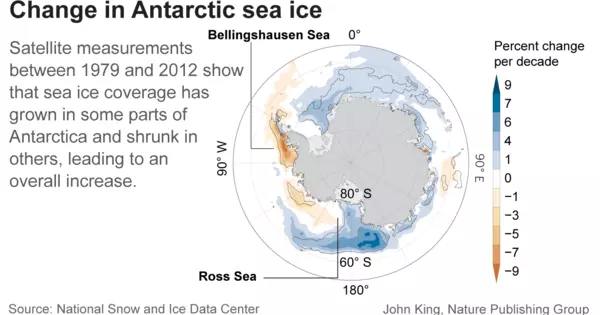Continuous satellite monitoring reveals that Antarctic sea ice has grown during the period of continuous satellite monitoring, contradicting ongoing global warming caused by rising greenhouse gas concentrations.An international team of scientists from the University of Hawaii at Manoa, the National Oceanic and Atmospheric Administration (NOAA), and South Korea show in a study published in Nature Climate Change that a multi-decadal swing of tropical sea surface temperatures and its ability to change atmospheric circulation across large distances is in large part responsible for the observed sea-ice expansion since the late 1970s.
Sea ice, which covers a large section of the ocean surface in the polar regions, helps to regulate world temperatures by reflecting incoming solar energy. Reduced sea-ice coverage is thus projected to increase greenhouse-gas-induced global warming. Changes in sea ice also have an impact on energy exchanges between the ocean and the atmosphere, carbon uptake by the ocean, ecosystems, and thermohaline oceanic circulation.
It is critical to track long-term changes in global sea ice and verify that the physical mechanisms that cause those changes are appropriately represented in climate prediction models.

The difference between simulations of computer models and observations
Continuous satellite data, which began at the end of the 1970s, shows that Arctic sea ice has decreased significantly over the satellite era, which is consistent with the global warming trend. In contrast, tiny but increasing trends have been recorded in the Southern Hemisphere, particularly between 1979 and 2014. Furthermore, while climate models can substantially recreate reported Arctic sea-ice decreases, the majority of them fail to reflect the Antarctic sea-ice expansion from 1979 to 2014.
For more than a decade, climate scientists have been confused by observed Antarctic sea-ice extension and model-observation mismatches, said lead author Eui-Seok Chung of the Korea Polar Research Institute.
“The observed Antarctic sea-ice expansion and model-observation discrepancy have perplexed climate scientists over more than a decade,”
Eui-Seok Chung, from the Korea Polar Research Institute.
Various hypotheses, such as increased freshwater fluxes due to sub-ice shelf melting, atmospheric and oceanic circulation changes associated with human-induced stratospheric ozone depletion, and tropical teleconnections, have been proposed to explain the observed Antarctic sea-ice expansion, said Axel Timmermann, director of the IBS Center for Climate Physics at Pusan National University.
The observed Antarctic sea-ice fluctuations are produced not only by rising greenhouse gas concentrations and/or stratospheric ozone depletion, but also by the natural variability of the climate system, which happens independently of human activity.
To find out what was causing the observed Antarctic sea-ice expansion and the model-observation discrepancy, the scientists looked to a longer record of Southern Ocean sea surface temperatures as a proxy for Antarctic sea ice and conducted comprehensive analyses of multi-model large ensemble climate model simulations.
Misalignment is caused by natural variability and regional model biases.
Over time, Southern Ocean cooling and accompanying atmospheric and oceanic circulation changes associated with natural variability in the tropics may temporarily overcome opposing human-induced changes, resulting in temporary sea ice extension. It does not, however, explain the model-observation gap.
“Southern Ocean multi-decadal variability is also closely linked to tropical natural variability in climate model simulations, but the linkages are significantly weaker than in observations,” explained Malte Stuecker, co-author and assistant professor of oceanography at the University of Hawaii at Manoa’s School of Ocean and Earth Science and Technology (SOEST). Thus, in model simulations, human-induced ocean surface warming prevails in the Southern Ocean. “
This project exemplifies UH Mnoa’s goal of excellence in research: advancing the research and creative work enterprise (PDF), one of four goals outlined in the 2015–25 Strategic Plan (PDF), which will be updated in December 2020.





